Evolution of oil-producing trichomes in Sisyrinchium (Iridaceae): insights from the first comprehensive phylogenetic analysis of the genus
- PMID: 21527419
- PMCID: PMC3101146
- DOI: 10.1093/aob/mcr080
Evolution of oil-producing trichomes in Sisyrinchium (Iridaceae): insights from the first comprehensive phylogenetic analysis of the genus
Abstract
Background and aims: Sisyrinchium (Iridaceae: Iridoideae: Sisyrinchieae) is one of the largest, most widespread and most taxonomically complex genera in Iridaceae, with all species except one native to the American continent. Phylogenetic relationships within the genus were investigated and the evolution of oil-producing structures related to specialized oil-bee pollination examined.
Methods: Phylogenetic analyses based on eight molecular markers obtained from 101 Sisyrinchium accessions representing 85 species were conducted in the first extensive phylogenetic analysis of the genus. Total evidence analyses confirmed the monophyly of the genus and retrieved nine major clades weakly connected to the subdivisions previously recognized. The resulting phylogenetic hypothesis was used to reconstruct biogeographical patterns, and to trace the evolutionary origin of glandular trichomes present in the flowers of several species.
Key results and conclusions: Glandular trichomes evolved three times independently in the genus. In two cases, these glandular trichomes are oil-secreting, suggesting that the corresponding flowers might be pollinated by oil-bees. Biogeographical patterns indicate expansions from Central America and the northern Andes to the subandean ranges between Chile and Argentina and to the extended area of the Paraná river basin. The distribution of oil-flower species across the phylogenetic trees suggests that oil-producing trichomes may have played a key role in the diversification of the genus, a hypothesis that requires future testing.
Figures


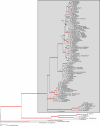
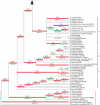



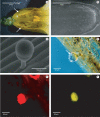
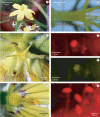

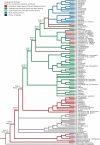
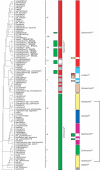
References
-
- Alves-dos-Santos I, Melo GAR, Rozen JG. Biology and immature stages of the bee tribe Tetrapediini (Hymenoptera: Apidae) American Museum Novitates. 2002;3377:1–45.
-
- APG III. An update of the Angiosperm Phylogeny Group classification for the orders and families of flowering plants: APG III. Botanical Journal of the Linnean Society. 2009;161:105–121.
-
- Baker JG. Systema Iridaceanum. Botanical Journal of the Linnean Society. 1878;16:61–180.
-
- Barker C. World checklist of Iridaceae. 2004 The Board of Trustees of the Royal Botanic Gardens, Kew. Published on the Internet: http://www.kew.org/wcsp/ accessed 5 November 2009.
-
- Bentham G, Hooker JD. Irideae: no.29. Sisyrinchium. In: Bentham G, Hooker JD, editors. Genera plantarum. 2. Vol. 3. London: L. Reeve and Co; 1883. pp. 698–699.

